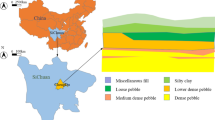Abstract
The temporary support of tunnel constructed through sequential excavation method is considered one key point because of its large deformation and complex force. The in-situ deformation of temporary support was monitored in two soil tunnels. Results show that the temporary support presents “convergence–expansion–stability” regularity in the horizontal direction and “settlement–uplift–stability” regularity in the vertical direction. Finite element numerical simulation method was used to obtain the displacement and stress of the temporary support based on the stratum geological parameters at tunnel site. Compared with the field test results, the numerical simulation values have differences, but the deformation rules are consistent. The temporary support bear not only axial force, but also the frequently variable bending moments and shear force. Combined the results of field test and numerical simulation, we proposed that the longitudinal connection reinforcement between each steel frame and steel fabric should be set in the temporary support. Alternatively, steel fiber-reinforced shotcrete could be used in the temporary support when necessary.
Similar content being viewed by others
References
Guo, Y. J., Huang, M. Q., Chen, T. L., ane Zhang, D. L. (2009). “Comparative analysis on the adaptability of CRD and dual sidewall guide pit for passing through the sand layer of xiamen seabed tunnel.” China Railway Science, Vol. 30, No. 2, pp. 58–60 (in Chinese).
Huai, P. S. and Zhao, X. P. (2010). “Double side-wall heading technique for big-span tunnels in israel carmel tunnels project.” Railway Construction Technology, Vol. 1, pp. 103–105 (in Chinese).
Jiang Annan, Li Peng, and Shi Hongtao (2011). “Shallow depth of the tunnel excavation response research based on CRD method.” Procedia Engineering, Vol. 15, pp. 4852–4856.
Koutsoftas, D. (2012). “State of practice: Excavation in soft soils.” Geotechnical Engineering State of the Art and Practice, pp. 678–728, DOI: 10.1061/9780784412138.0025.
Lai, J. X., Qiu, J. L., Fan, H. B., Zhang, Q., Hu, Z. N., Wang, J. B., and Chen, J. X. (2016). “Fiber bragg grating sensors-based in-situ monitoring and safety assessment of loess tunnel.” Journal of Sensors, Vol. 2016, pp. 1–10, DOI: 10.1155/2016/8658290.
Luo, Y. B., Chen, J. X., Xi, W. Z., Zhao,P.Y., Qiao, X., and Deng, X. H. (2016). “Analysis of tunnel displacement accuracy with total station.” Measurement, Vol. 83, pp. 29–37, DOI: 10.1016/j.measurement. 2016.01. 025.
Luo, Y. B., Chen, J. X., Huang, P., Tang, M. Q., Qiao, X., and Liu, Q. (2017). “Deformation and mechanical model of temporary support sidewall in tunnel cutting partial section.” Tunnelling & Underground Space Technology, Vol. 61, pp. 40–49, DOI: 10.1016/j.tust.2016. 09.007.
Kim, N. Y. and Chung, H. S. (2002). “A study on prediction of final displacement of road tunnel section during excavation in highly weathered rock by NATM.” KSCE Journal of Civil Engineering, Vol. 6, No. 4, pp. 399–405, DOI: 10.1007/BF0284 1994.
Choi, S. O. and Shin, H.-S. (2004). “Stability analysis of a tunnel excavated in a weak rock mass and the optimal supporting system design.” International Journal of Rock Mechanics and Mining Sciences, Vol. 41, pp. 876–881.
Sakurai, S. and Takeuchi, K. (1983). “Back analysis of measured displacements of tunnels.” Rock Mechanics and Rock Engineering, Vol. 16, pp. 173–180.
Sharifzadeh, M., Kolivand, F., Ghorbani, M., and Yasrobi, S. (2013). “Design of sequential excavation method for large span urban tunnels in soft ground-Niayesh tunnel.” Tunnelling and Underground Space Technology incorporating Trenchless Technology Research, Vol. 35, pp. 178–188.
Janda, T., Šejnoha, M., and Šejnoha, J. (2013). “Modeling of soil structure interaction during tunnel excavation: An engineering approach.” Advances in Engineering Software, Vols. 62-63, pp. 51–60.
Wang, M. S., Hong, K. R., Gan, K., R., and Yang, H. J. (2010). Tunnelling and Underground Engineering Technology in China: China Communications Press, Beijing.
Wang, M. N., Lu, J. F., Liu, D. G., and Zhang, J. G. (2010). “Study of absolute deformation control criterion and its application for large section subsea tunnel with CRD method.” Rock and Soil Mechanics, Vol. 3, No. 10, pp. 3354–3360 (in Chinese).
Zhang, D. (2011). “The influence of excavation in red clay by six sections with CRD Method on the values subsidence and structural internal force.” ICPTT 2011, pp. 1834–1844, DOI: 10.1061/4 1202(423)194.
Zhang, J. G., Wang, M. N., and Yu, S. Y. (2007). “Analysis on deformation of central diaphragms of tunnels constructed by CRD method: Case study on xian’an sub-sea tunnel in xiamen.” China Tunnel Construction, Vol. 27, No. 4, pp. 16–19 (in Chinese).
Author information
Authors and Affiliations
Corresponding author
Rights and permissions
About this article
Cite this article
Luo, Y., Chen, J., Wang, H. et al. Deformation rule and mechanical characteristics of temporary support in soil tunnel constructed by sequential excavation method. KSCE J Civ Eng 21, 2439–2449 (2017). https://doi.org/10.1007/s12205-016-0978-3
Received:
Accepted:
Published:
Issue Date:
DOI: https://doi.org/10.1007/s12205-016-0978-3




